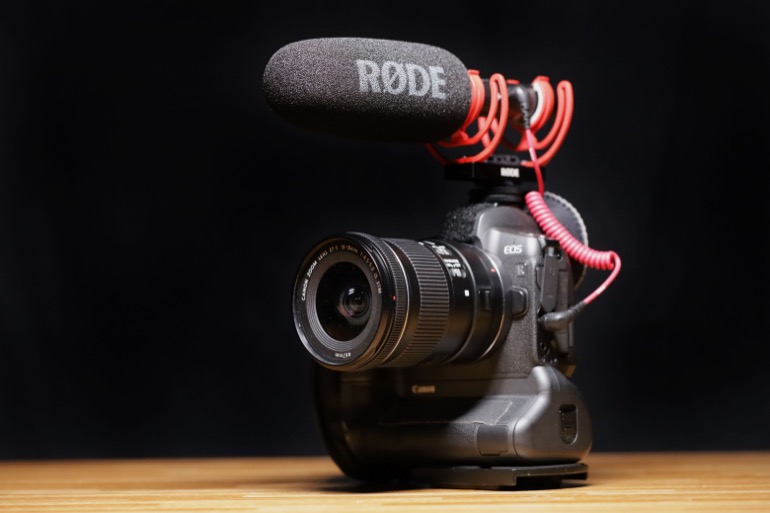Rode VideoMic NTG Review
It's now about 15 years after the original RØDE VideoMic was released, and chances are that today you probably have a Rode mic in your arsenal. Maybe you have one of the various flavors of VideoMics currently sitting on top of your mirrorless or DSLR camera, or you have one of the NTG shotgun mics attached to your cinema camera or camcorder.
The Rode mics have served you well, and yet, you probably continue to look at other microphones out there, maybe out of boredom, maybe out of curiosity. Could a Sennheiser MKH 416 completely change the audio game for you (hint: it won’t)? Maybe getting a mic that’s longer than your current on-camera mic will drastically improve your sound quality (hint: or maybe move a few inches closer to the subject)?
Or maybe the new offering from Rode is worth checking out? There’s quite a few on-camera mics to pick from, as we’ve written about in our Rode mics article. Lately there’s also the Rode NTG5, which is the latest and greatest traditional shotgun from Rode.
_And then of course, there’s theRode VideoMic NTG, which we’re reviewing here. _
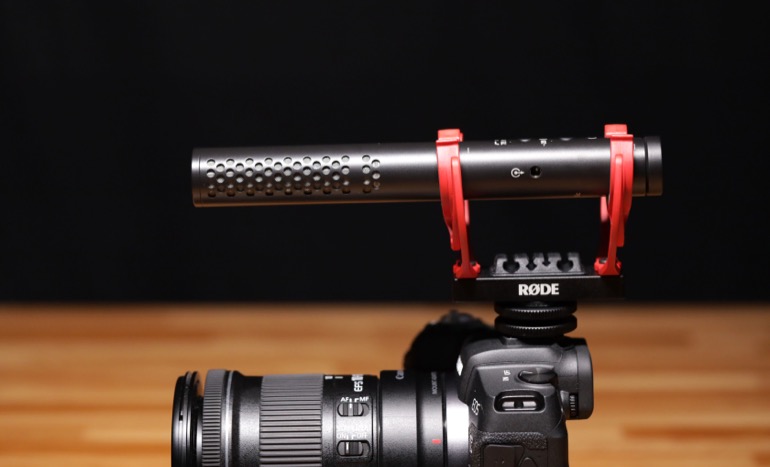
The truth is, a new mic that’s largely similar to the one you currently have isn’t going to change your workflow or output much at all. As we wrote in our comparing microphones article, the slight differences in sound quality between different mics is only useful if you’re shooting with multiple mics and need them to match up as close as possible. It’s like shooting flat picture profiles for visuals - you want the differences between cameras to be minimal, so the audience doesn’t notice a change from shot to shot.
But in a production with only one mic, within the first few seconds the audience will become accustomed to the unique sound of that mic, and they’ll simply hear the story rather than notice whether a mic sounds particularly bassy or noisy. The difference is only noticeable when you introduce another mic into the same production.
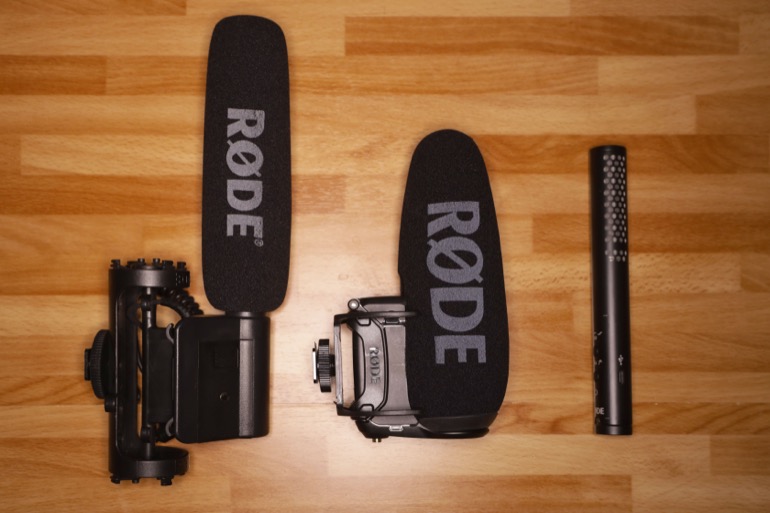
So if you’re moderately happy with your current mic, whether it’s on-camera, on a boom, or on a tabletop, then why look at other mics at all? Well, one reason is because a different mic is made for a different purpose than the one you currently have. Like using short shotguns for outdoor situations, and small diaphragm condenser mics (like our favorite Audio Technica AT4053B) for indoor interviews.
Another reason to consider a different mic is if it has unique features than what your current mic has to offer. And that’s why the Rode VideoMic NTG is grabbing everyone’s attention right now. It’s not just an alternative to Rode’s other on-camera mics, it’s a completely different beast altogether.
Rode VideoMic NTG - A new mic altogether
What’s in a name? The VideoMic NTG is the first child of Rode’s two established video microphone product lines: the NTG and the VideoMic series. The bad news is the name gets lost in search results. The good news is it’s a mashup that spawns the best of both worlds.
Inside this hybrid microphone are the guts from the NTG5, Røde’s newest short shotgun. It’s a complete redesign of their top of the line broadcast-quality shotgun, the NTG3.
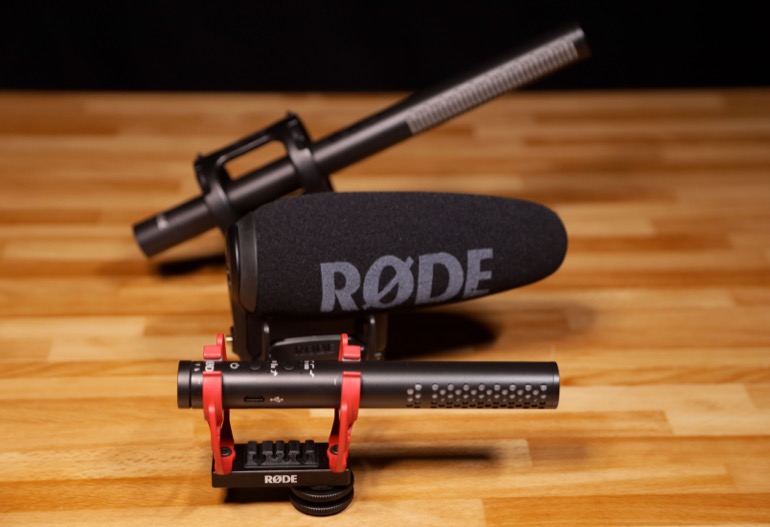
If you need a brief catch up, the NTG lineup began with the NTG1 and NTG2, which were both budget friendly shotgun mics (the NTG2 included a battery as an alternative to Phantom Power).
Then came the NTG3, which is on a different level and is meant to compete with industry standard mics such as the Sennheiser MKH 416. It’s got an RF bias and build quality that can withstand the toughest conditions and is usually only seen in mics costing $1000 and up.
Rode later released the NTG8, which has the same guts as the NTG3 but in a long, highly directional form factor. We did a review of the NTG8 Long Shotgun and it’s found a lot of use in our music performance videos and docu and corporate interviews.
About 10 years after the original NTG1 and NTG2 were released, Rode came out with the NTG4 and NTG4+, the next generation of these affordable short shotgun mics. Both mics offer a lot of bang for the buck, and we’ve utilized the NTG4+ in a variety of productions. But at the time of their release, everyone was wondering what would happen to the NTG3, if it would forever be a high end orphan in between Rode’s affordable lineup?

When the NTG5 came out, Rode took everything good about the NTG3 and made it significantly smaller and lighter, with a flatter response, more sensitivity, and at a lower price. The mic was an instant winner.
But a few months later the Rode VideoMic NTG came out, and it not only has the guts of the NTG5, but also the compact body, killer extra features, and affordable price point that all seemed a little too good to be true. Except there’s nothing fishy about it all - the VideoMic NTG is just a damned good product and everyone should consider one, even if you already have other mics.
Below is a little comparison we did with a few different microphones, including the original VideoMic, VideoMic Pro Plus, VideoMicro, VideoMic NTG, NTG4+, and a Deity S-Mic 2.
Rode VideoMic NTG features
The VideoMic NTG comes with a few features that are surprising and welcome, and will probably become so essential to you that you wonder how you lived without them.
First of all, the VideoMic NTG has a supercardioid polar pattern that is more directional than previous VideoMics. It has a flat response that is uncolored, and the off-axis rejection is supposedly also very neutral. The mic is designed with a new capsule and round acoustic ports rather than the linear windows typically found in a shotgun interference tube.

The mic comes with a new style of Rycote shock mount, one that puts the shoe adapter on a sliding base. That way, you can move the mic and its mount forward and backward on top of your camera, to ensure it’s out of the way from your eyepiece or viewfinder, but doesn’t show up in an ultrawide lens.
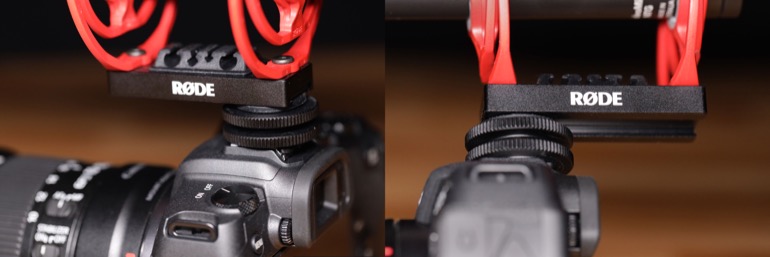
The mount also has a few different sizes of cable holders, so you can manage a variety of cable sizes in order to keep your camera rig clean and organized. There’s also a ¼-20 thread on the bottom of the shoe adapter, if you want to use the mic on a camera cage, boom pole, pistol grip, and other accessory mounts.
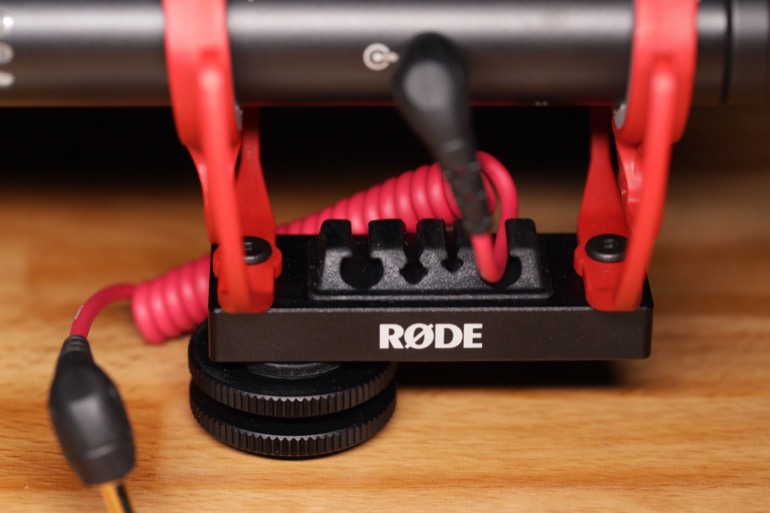
The VideoMic NTG is super lightweight, coming in at 3.3 oz, less than even the VideoMic Pro Plus. And it’s only about 6.5 inches long. The original VideoMic weighs twice as much, and is 10 inches long. This is a definitely compact, even though it has so many new features and aerospace grade aluminum housing.
Safety Track
On the microphone, you can choose digital switching between a -20db pad when recording in a loud environment, a high pass filter of 75hz or 150hz to eliminate low end rumble, and a high frequency shelf boost to counteract the dulling effect of windshields and deadcat furries.
But probably the most usable feature of all is the Safety Channel, which sends a signal -20db lower into the right channel, ensuring you’ll never come back with completely clipped and unusable audio. That’s especially useful on DSLRs and mirrorless cams that only have one microphone port.
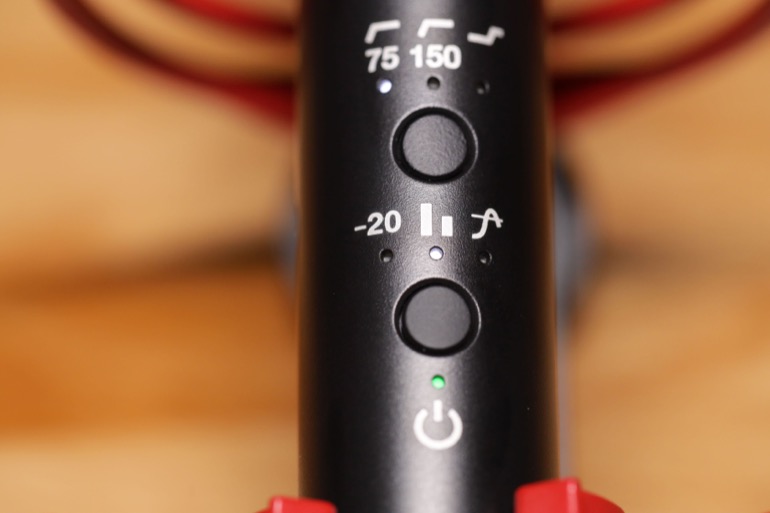
On cinema cameras, you can usually seperate an incoming mic into two channels and manually reduce the second channel, either via menus or with a physical XLR splitter that sends one mic signal into two channels. But on compact cameras, you just have the one 3.5mm input jack, and we don’t know of any DSLRs or mirrorless cameras that have a safety channel feature included in the camera software.
So, all you have to do is take the stereo audio feed that is recorded along with your video, and in your editing program, simply turn off the right channel and you’ll have a dual-mono audio source that is perfectly fine in 90% of your shots. But for those few times where your audio clipped - maybe because the subject became much hotter all of a sudden, or you forgot to pay attention to the audio levels - now you’ve got a safety track that you can fall back on anytime.
Auto Power and TRS Sensor
If you haven’t yet experienced the beauty of Rode’s auto power on and off feature in their VideoMics, you’re in for a treat. Probably the worst feeling in the world is traveling to a video production, only to find that you accidentally left something on and drained the battery. With so many pieces of gear to track - and these days with everything being battery powered - this can be a common nightmare.
To defeat the draining battery, you could take the battery out of a mic when it’s not in use, or carry spares. But then you’re potentially walking into a situation where you’re about to start rolling and you realize your mic’s battery is not installed - also not a good place to be.
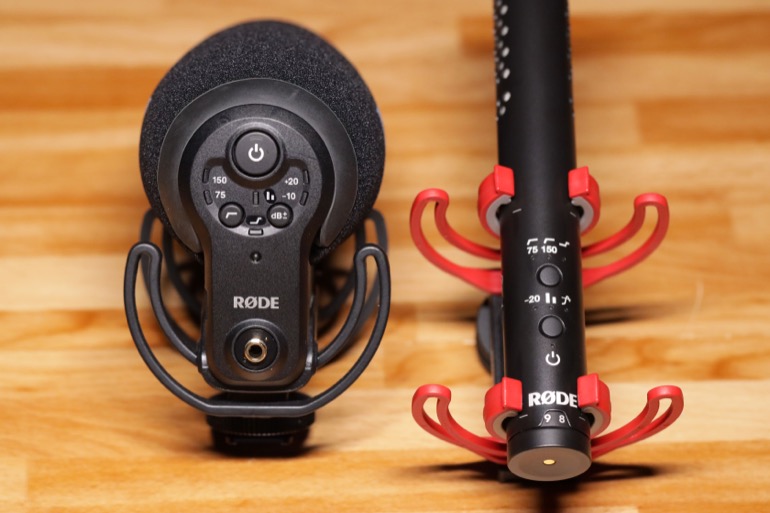
The VideoMic Pro Plus also had the auto power on feature
The VideoMic NTG has an internal-only battery, so you couldn’t take it out or replace it yourself even if you wanted to. Internal rechargeable batteries are often required in highly compact and sophisticated electronics, but it’s not great for the end user. Eventually the battery will degrade, and there’s no way you can change it yourself.
Fortunately RODE has a generous 10 year warranty to solve any potential battery issues, and on the VideoMic NTG, you have an auto sensor that will turn off your mic as soon as the camera is turned off or you pull the plug out. That means that the 30-hour battery will never drain unless you physically turn the mic on yourself, outside of it being plugged into anything, and then leave it on.
And of course, having an auto-on feature means you have one less thing to worry about when you’re quickly getting ready to shoot. You just leave the VideoMic NTG rigged and plugged into your camera, and whenever you turn the camera on, the mic is ready to roll with it.
In addition to the auto power sensor, the mic will also know whether you have it plugged into a regular camera, or a smartphone or tablet device that uses a TRSS connection. That means you don’t have to carry separate cables or adapters. Except you do have to carry a Lightning to 3.5mm Headphone Jack adapter because iPhones don’t have TRSS 3.5mm jacks anymore.
Infinitely Variable Gain Control
One of the great features of a wireless mic kit connected to a professional preamp or mixer, or even a cinema camera, is you have all these different places where you can finetune your gain. Whereas some people might be frightened by gain staging - figuring out at what gain to set each piece until you arrive at the cleanest signal into your camera or recorder - we think it gives you much more control.
Unfortunately with most shotgun mics connected to DSLR or Mirrorless cameras, you have very little control over where to increase or decrease gain. In fact, most of the time, you only have the camera’s preamp, which is essentially all digital gain and the worst place to pump gain up. But what can you do? Adding a preamp between your microphone and camera can significantly increase the bulkiness of your compact rig.
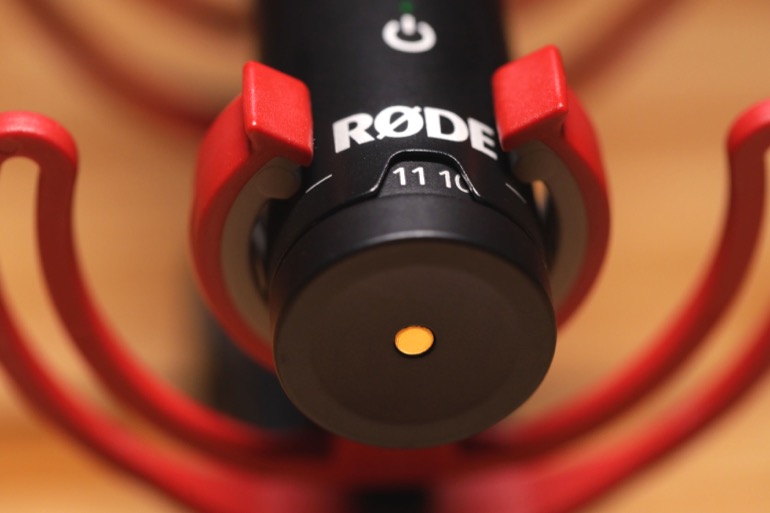
That’s why the second VideoMic from Rode, the VideoMic Pro, became such a hit for DSLR shooters. You had an on-camera switch that gave you 0db, -10db, or a +20db option, handing you a ton more control before the audio even touched the camera’s digital preamp.
Now you have even more control with the VideoMic NTG, infinte control actually. The gain wheel can go from line to mic level - so you can place all of the preamplification on the microphone’s hardware, while setting your camera’s preamp to the lowest possible setting.
To do this, you simply move your camera’s mic input level all the way left to zero, then right one notch. Then you adjust the mic’s gain wheel until your levels sound good. Now you’re recording the cleanest possible signal to your camera, and you can adjust it as needed.
At first, we thought the Safety Channel was going to be the reason why we put the VideoMic NTG on all our cameras from now on. But after using it a bit, it’s the infinite variable gain control that makes this microphone better suited for on-camera work than any mic we’ve ever used.
Rode VideoMic NTG as a USB Mic
If any of the above features isn’t enough reason to get the VideoMic NTG, the fact that you can also use it as a plug-and-play USB mic may seal the deal for you.
The mic comes with a USB-C connection, and a USB-C to USB-A cable that connects either to a wall adapter or a battery or computer to charge the internal battery. But if you plug it into your computer, it becomes instantly recognizable as a microphone, and now you can record voice overs, or a podcast, or use it for Skype calls, instantly.
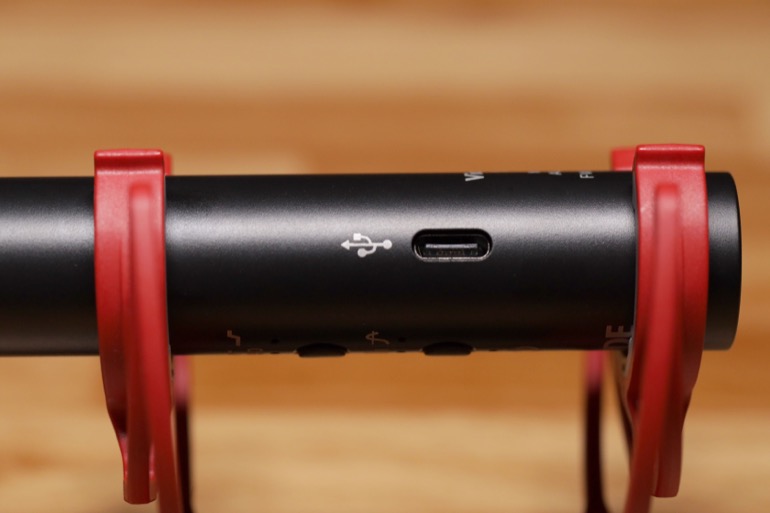
We attached the mic on top of a Joby Gorillapod and held it to record VO, and it couldn’t be any easier. There was no handling noise, we didn’t need to use a USB tabletop mixer, or a mic stand, or a pop shield, or any other accessory. The low self noise of the microphone is really evident when using it on a handheld pistol grip or gorillapod.
And while the mic is being used as a USB mic, you can also plug in your headphones into the 3.5mm audio jack on the mic, and control the headphone volume with the mic’s variable gain wheel. That means you can listen to the mic’s output, while feeding your computer’s headphone jack into other speakers, or another pair of headphones. Or maybe you want to monitor the mic’s output cleanly before your computer setup adds effects.
You can plug the mic into smartphones or tablets, too. You could use your own USB-C to USB-C cable, or if you’ve got a bunch of USB-C/USB-A adapters lying around, that works too. We used an adapter on a new-ish MacBook Pro with USB-C ports, and the mic was recognized instantly.
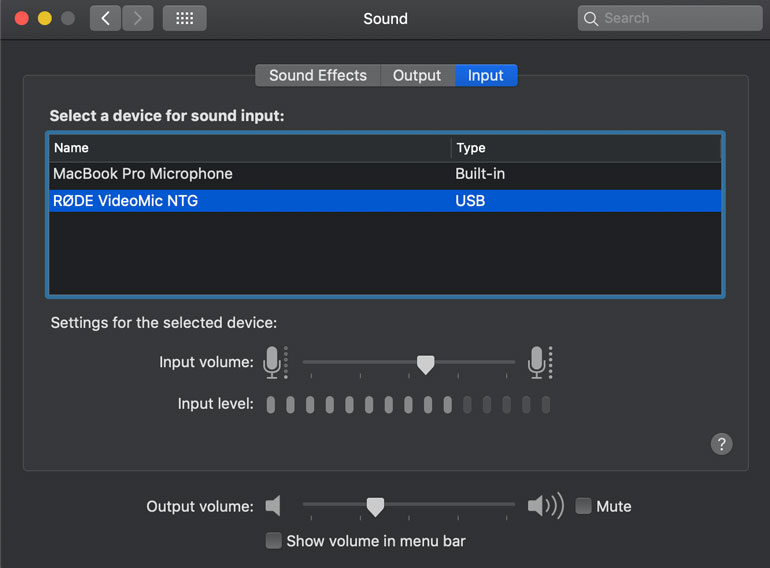
New Updates
Since the launch of the VideoMic NTG, RØDE has made the mic more compelling with some updates.
The first is the WS11 Windshield. Or windscreen, deadcat, furry, muff, whatever you like to call it. This is a much more powerful wind noise reducer than the thin foam screen that comes default with the mic.
To be honest, once we received ours we haven't taken it off the VideoMic NTG, not even for indoor shoots.
Why? Because first, if it's not on the mic, then chances are when you need it, it'll be far from you in a bag. And two, the windshield does a great job of protecting the mic from drops, moisture, mishandling, and just everyday use. You won't lose any audio fidelity, so we recommend just leaving it on full time.
The other addition to this already packed microphone is a new firmware update and special cables that enable you to use the VideoMic NTG with phones and tablets.
With the firmware update and the new SC-15 cable, you can now plug the microphone directly into the Lightning port on an iOS device. It's a little under a foot long, but also includes a junction box to neatly tuck away the cable.
Why is this a big deal? Haven't there been mics available for iOS devices for a while now? The difference here is you can now monitor the audio with your headphones connected to the mic itself - helpful since Apple removed the headphone port on all its devices. And second, you can control the level using the volume knob on the mic. This is huge because there's really no good way to control mic levels in iOS apps.
We're very happy with this new addition because many people are now using their phones and tablets for video conferencing, and occasionally we video creators have to rely on this footage for some editing projects, now that in-person interviews are on pause during the global pandemic.
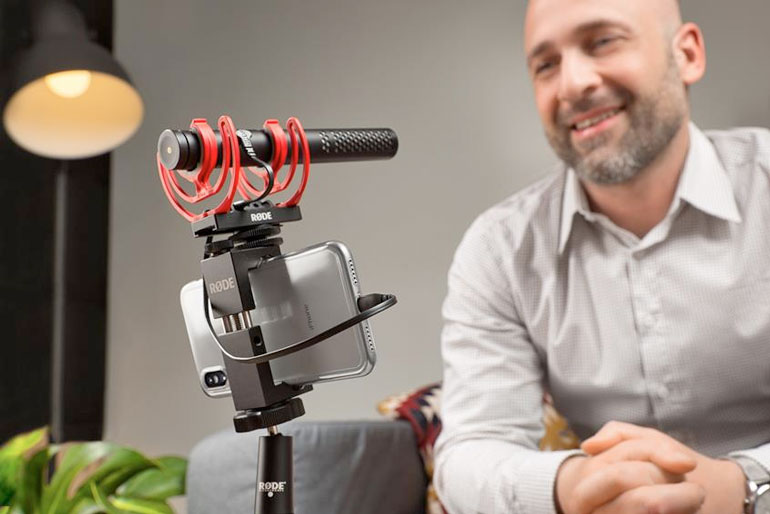
Additionally, many projects now rely on voice overs that are self-recorded by our clients and subjects, but the learning curve to use any kind of professional hardware or software is too difficult for most people. So often we recommend to just speak into a phone, using the default voice record app.
But with the small built-in mic, and without a way to monitor the audio and easily adjust the levels, we frequently get mediocre results. Now we'll simply ensure our clients and subjects have access to a VideoMic NTG and SC-15 cable, and that combo will be easier and more dependable than any solution so far. The safety track in iOS recordings alone is a life saver.
Android users, rejoice! Rode has also created the SC-16 cable, which is USB-C to USB-C rather than a Lightning terminal, with all of the same functionality as the SC-15 cable. You may also want to get a phone mount with a built in shoe insert for the mic, like this one.
Conclusion
We’re not quite sure what Rode intends to do after this mic. It really has everything - a mix of the newest NTG broadcast-level acoustics, along with VideoMic on-camera mic features, and now the ability to use it directly as a USB-C microphone. There’s a whole lot of features here, especially with such a low retail price.
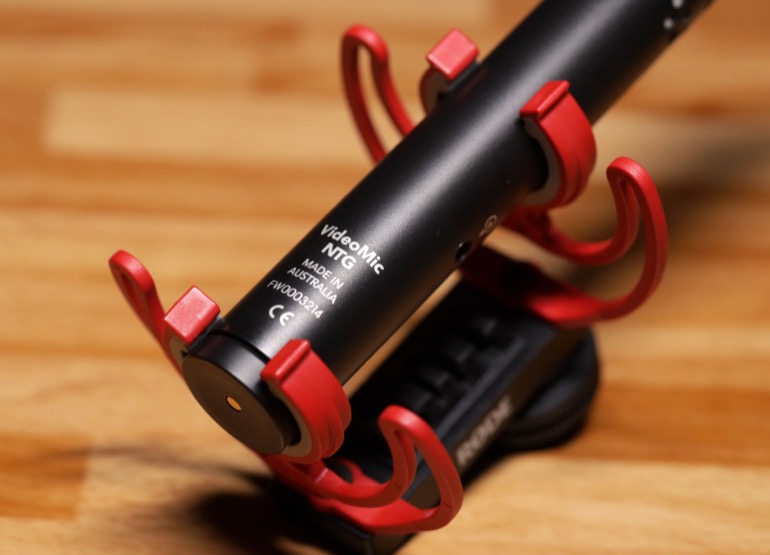
Perhaps Rode is aiming to do again what it did with the original VideoMic - get a revolutionary, affordable mic into as many people’s hands (and on their cameras) as possible. That way, more filmmakers are recording better audio, which means all their friends and family and audiences hear better audio, which means many more potential Rode customers down the road. Well, at least that’s our theory.
We’re super impressed with the Rode VideoMic NTG - it’ll live in our camera now, and we’ll quickly attach it to our computer for easy VO, and we may even start using it for boomed interviews.
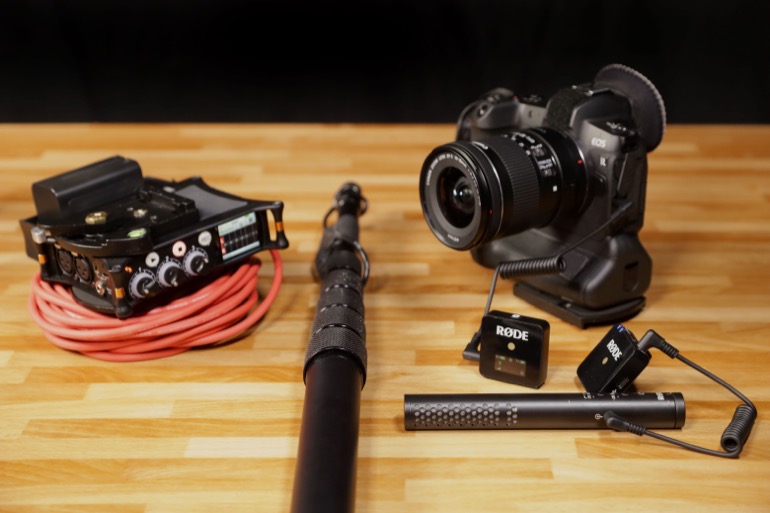
Combined with the Rode Wireless GO, we now even have a lightweight interview boom kit that doesn’t need a big preamp mixer like the Sound Devices MixPre-3. The infinately variable gain control does away with needing a preamp / mixer when sending a boom mic signal into a compact DSLR or Mirrorless camera. And the Wireless GO reduces the need for a long cable.
Turns out, being able to control a microphone’s gain level on the microphone itself is quite a handy feature. We’re looking forward to better audio while using little cameras. Bad Audio is dead. Long live the VideoMic NTG.
RØDE VideoMic NTG - B&H Photo | Amazon
